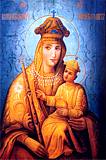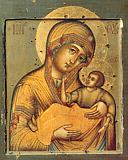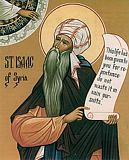

| Previous day | Next day |
| Old Style
April 12
|
Saturday |
New Style
April 25
|
| Bright Week. Fast-free period. | No fast.
|
St. Basil the Confessor, bishop of Parium (754).
Hieromartyr Zeno, bishop of Verona (ca. 260). St. Isaac the Syrian, abbot, of Spoleto, Italy (550). Monk-martyrs Menas, David, and John, of Palestine (after 636). Virgin Anthusa of Constantinople (801). St. Athanasia the Wonderworker, abbess, of Aegina (860).
Deposition of the Cincture [Sash] of the Most Holy Theotokos in Constantinople (942).
St. Sergius II, patriarch of Constantinople (1019). St. Basil, bishop of Ryazan (1295). St. Acacius of Kapsokalyvia Skete, Mt. Athos (1730). Martyr Sabbas the Goth, at Buzau in Wallachia (372).
Repose of Archbishop Juvenal of Vilnius, Lithuania, monk of Optina Monastery (1904).
Thoughts for Each Day of the Year
According to the Daily Church Readings from the Word of God
By St. Theophan the Recluse

Saturday. [Acts 3:11–16; John 3:22–33]
We have two lives, fleshly and spiritual. Our spirit is as though buried in our flesh. Once it begins to extract itself—coming to life by God’s grace—from its intertwining with the flesh and to appear in its spiritual purity, then it will be resurrected, or it will resurrect itself piece by piece. When it wholly tears itself out of this binding, then it comes forth as if from a tomb, in a renewed life. In this manner the spirit becomes separate, alive and active; whereas the tomb of the flesh is separate, dead and inactive, though both are in the same person. This is the mystery of what the apostle says: where the Spirit of the Lord is, there is liberty (II Cor. 3:17). This is liberty from decay, which surrounds our incorruptible spirit; or from passions, corrupting our nature. This spirit, entering into the freedom of the children of God is like a beautifully coloured butterfly, fluttering away from its cocoon. Behold its rainbow colouring: love, joy, peace, longsuffering, gentleness, goodness, faith, meekness, temperance (Gal. 5:22). Is it possible for such a beauty of perfection not to arouse in us a desire to emulate it?
Articles
 Hieromartyr Zeno the Bishop of VeronaSaint Zeno, Bishop of Verona, was born a Greek and came from Syria. In his youth he became a monk and devoted himself to the study of Holy Scripture. |
 Monk-martyrs Menas, David, and John, of PalestineThey were martyred in the seventh century by Arabs. |
 The Venerable Anthusa of ConstantinopleThe holy princess Anthusa of Constantinople was the daughter of the Iconoclast emperor Constantine Copronymos (reigned 741-775) and his third wife Eudokia. |
 Venerable Athanasia the Abbess of AeginaSaint Athanasia was abbess of a monastery on the island of Aegina in the ninth century. |





